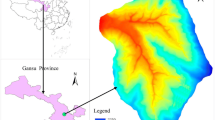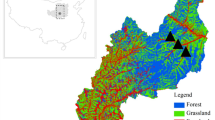Abstract
Soil moisture is a limiting factor of ecosystem development in the semi-arid Loess Plateau. Characterizing the soil moisture response to its dominant controlling factors, such as land use and topography, and quantifying the soil-water carrying capacity for revegetation is of great significance for vegetation restoration in this region. In this study, soil moisture was monitored to a depth of 2 m in three land use types (native grassland, introduced grassland, and forestland), two landforms (hillslope and gully), and two slope aspects (sunny and shady) in the Nanxiaohegou watershed of the Loess Plateau, Northwest China. The MIKE SHE model was then applied to simulate the soil moisture dynamics under different conditions and determine the optimal plant coverage. Results showed that the average soil moisture was higher in native grassland than in introduced grassland and Platycladus orientalis forestland for a given topographic condition; however, a high soil moisture content was found in Robinia pseudoacacia forestland, with a value that was even higher than the native grassland of a sunny slope. The divergent results in the two forestlands were likely attributed to the differences in plant coverage. Gully regions and shady slopes usually had higher soil moisture, while lower soil moisture was usually distributed on the hillslope and sunny slope. Furthermore, the mean absolute relative error and Nash-Sutcliffe efficiency coefficient of the MIKE SHE model ranged between 2.8%–7.8% and 0.550–0.902, respectively, indicating that the model could effectively simulate the soil moisture dynamics. The optimal plant coverage was thus determined for hillslope P. orientalis by the model, corresponding to a leaf area index (LAI) value of 1.92. Therefore, for sustainable revegetation on the Loess Plateau, selecting suitable land use types (natural vegetation), controlling the planting density/LAI, and selecting proper planting locations (gully and shady slope regions) should be considered by local policy makers to avoid the over-consumption of soil water resources.
Similar content being viewed by others
References
Burt TP, Butcher DP (1985) Topographic controls of soil moisture distributions. Eur J Soil Sci 36(3): 469–486. https://doi.org/10.1111/j.1365-2389.1985.tb00351.x
Deng L, Yan WM, Zhang YW, et al. (2016) Severe depletion of soil moisture following land-use changes for ecological restoration: Evidence from northern China. For Ecol Manage 366: 1–10. https://doi.org/10.1016/j.foreco.2016.01.026
DHI (Danish Hydraulic Institute) (2017) MIKE SHE User Manual. Danish Hydraulic Institute, Hørsholm, Denmark. pp 270–288.
Duan LX, Huang MB, Zhang LD (2016) Differences in hydrological responses for different vegetation types on a steep slope on the Loess Plateau, China. J Hydrol 537: 356–366. https://doi.org/10.1016/j.jhydrol.2016.03.057
Fang XN, Zhao WW, Wang LX, et al. (2016) Variations of deep soil moisture under different vegetation types and influencing factors in a watershed of the Loess Plateau, China. Hydrol Earth Syst Sci 20(8): 3309–3323. https://doi.org/10.5194/hess-20-3309-2016
Feng XM, Fu BJ, Piao SL, et al. (2016) Revegetation in China’s Loess Plateau is approaching sustainable water resource limits. Nat Clim Chang 6(11): 1019–1022. https://doi.org/10.1038/nclimate3092
Feng XM, Li JX, Cheng W, et al. (2017). Evaluation of AMSR-E retrieval by detecting soil moisture decrease following massive dryland re-vegetation in the Loess Plateau, China. Remote Sens Environ 196: 253–264. https://doi.org/10.1016/j.rse.2017.05.012
Fu BJ, Wang S, Liu Y, et al. (2017) Hydrogeomorphic ecosystem responses to natural and anthropogenic changes in the Loess Plateau of China. Annu Rev Earth Planet Sci 45(1): 223–243. https://doi.org/10.1146/annurev-earth-063016-020552
Fu W, Huang M, Gallichand J, et al. (2012) Optimization of plant coverage in relation to water balance in the Loess Plateau of China. Geoderma 173: 134–144. https://doi.org/10.1016/j.geoderma.2011.12.016
Gao X, Wu P, Zhao X, et al. (2011) Soil moisture variability along transects over a well-developed gully in the Loess Plateau, China. Catena 87: 357–367. https://doi.org/10.1016/jxatena.2011.07.004
Gao X, Zhao X, Wu P, et al. (2016) Effects of large gullies on catchment-scale soil moisture spatial behaviors: a case study on the Loess Plateau of China. Geoderma 261: 1–10. https://doi.org/10.1016/j.geoderma.2015.07.001
Gao XD, Wu PT, Zhao XN, et al. (2014) Effects of land use on soil moisture variations in a semi — arid catchment: Implications for land and agricultural water management. Land Degrad Dev 25(2): 163–172. https://doi.org/10.1002/ldr.1156
Guo ZS, Shao MA (2004) Mathematical model for determining vegetation carrying capacity of soil water. J Hydraul Eng 10: 95–99. (in Chinese)
Huang YL, Chen LD, Fu BJ, et al. (2012) Effect of land use and topography on spatial variability of soil moisture in a gully catchment of the Loess Plateau, China. Ecohydrology 5(6): 826–833. https://doi.org/10.1002/eco.273
Jian SQ, Zhao CY, Fang SM, et al. (2015) Effects of different vegetation restoration on soil water storage and water balance in the Chinese Loess Plateau. Agric For Meteorol 206: 85–96. https://doi.org/10.1016/j.agrformet.2015.03.009
Jin Z, Guo L, Lin H, et al. (2018) Soil moisture response to rainfall on the Chinese Loess Plateau after a long — term vegetation rehabilitation. Hydrol Process 32(12): 1738–1754. https://doi.org/10.1002/hyp.13143
Kristensen KJ, Jensen SE (1975) A model of estimating actual evapotranspiration from potential evapotranspiration. Nord Hydrol 6(3): 170–188. https://doi.org/10.2166/nh.1975.0012
Liang W, Bai D, Wang FY, et al. (2015) Quantifying the impacts of climate change and ecological restoration on streamflow changes based on a Budyko hydrological model in China’s Loess Plateau. Water Resour Res 51(8): 6500–6519. https://doi.org/10.1002/2014WR016589
Liu BX, Shao MA (2015) Modeling soil-water dynamics and soil-water carrying capacity for vegetation on the Loess Plateau, China. Agric Water Manage 159: 176–184. https://doi.org/10.1016/j.agwat.2015.06.019
Liu HJ, Liu SZ, Li Y, et al. (2012) Response of riparian vegetation to the change of groundwater level at middle and lower reaches of the Shiyang River. Arid Zone Res 29(2): 335–341. (in Chinese)
Longobardi A (2008) Observing soil moisture temporal variability under fluctuating climatic conditions. Hydrol Earth Syst Sci 5(2): 935–969. https://doi.org/10.5194/hessd-5-935-2008
Ma L, He CG, Bian HF, et al. (2016) MIKE SHE modeling of ecohydrological processes: Merits, applications, and challenges. Ecol Eng 96: 137–149. https://doi.org/10.1016/j.ecoleng.2016.01.008
McColl KA, Alemohammad SH, Akbar R, et al. (2017) The global distribution and dynamics of surface soil moisture. Nat Geosci 10(2): 100–104. https://doi.org/10.1038/ngeo2868
Mei XM, Ma L, Zhu QK, et al. (2018) Responses of soil moisture to vegetation restoration type and slope length on the loess hillslope. J Mt Sci 15(3): 548–562. https://doi.org/10.1016/j.agwat.2015.06.019
Monteith JIL (1965) Evaporation and environment. Symposia of the Society for Experimental Biology 19: 205–234.
Murphy PNC, Ogilvie J, Arp P (2009) Topographic modelling of soil moisture conditions: a comparison and verification of two models. Eur J Soil Sci 60(1): 94–109. https://doi.org/10.1111/j.1365-2389.2008.01094.x
Poltoradnev M, Ingwersen J, Streck T (2016) Spatial and temporal variability of soil water content in two regions of Southwest Germany during a three-year observation period. Vadose Zone J 15(6). https://doi.org/10.2136/vzj2015.11.0143
Refsgaard JC, Storm B (1995) MIKE SHE, in Computer Models of Watershed Hydrology. Water Resources Publications, Englewood, USA. pp 809–846.
Rodriguez-Iturbe I, D’odorico P, Porporato A, et al. (1999) On the spatial and temporal links between vegetation, climate, and soil moisture. Water Resour Res 35(12): 3709–3722. https://doi.org/10.1029/1999WR900255
Rujner H, Leonhardt G, Marsalek J, et al. (2018) Highresolution modelling of the grass swale response to runoff inflows with Mike SHE. J Hydrol 562: 411–422. https://doi.org/10.1016/j.jhydrol.2018.05.024
Shen MS, Zhang JJ, Zhang SH, et al. (2020) Seasonal variation of the influence of vegetation cover on soil water on the loess hillslope. J Mt Sci 17(6): 2148–2160. https://doi.org/10.1007/s11629-019-5942-5
Sonnenborg TO, Christiansen JR, Pang B, et al. (2017) Analyzing the hydrological impact of afforestation and tree species in two catchments with contrasting soil properties using the spatially distributed model MIKE SHE SWET. Agric For Meteorol 239: 118–133. https://doi.org/10.1016/j.agrformet.2017.03.001
Sultan D, Song YD, Marina J (2004) Influence of groundwater level change on vegetation coverage and their spatial variation in arid regions. J Geogr Sci 14(3): 323–329. https://doi.org/10.1007/BF02837413
Suo LZ, Huang MB, Zhang YK, et al. (2018) Soil moisture dynamics and dominant controls at different spatial scales over semiarid and semi-humid areas. J Hydrol 562: 635–647. https://doi.org/10.1016/j.jhydrol.2018.05.036
Thompson JR, Green AJ, Kingston DG (2014). Potential evapotranspiration-related uncertainty in climate change impacts on river flow: An assessment for the Mekong River basin. J Hydrol 510: 259–279. https://doi.org/10.1016/j.jhydrol.2013.12.010
Tian J, Zhang BQ, He CS, et al. (2019) Dynamic response patterns of profile soil moisture wetting events under different land covers in the Mountainous area of the Heihe River Watershed, Northwest China. Agric For Meteorol 271: 225–239. https://doi.org/10.1016/j.agrformet.2019.03.006
Tong YP, Wang YQ, Song Y, et al. (2020) Spatiotemporal variations in deep soil moisture and its response to land-use shifts in the Wind-Water Erosion Crisscross Region in the Critical Zone of the Loess Plateau (2011–2015), China. Catena 193: 104643. https://doi.org/10.1016/j.catena.2020.104643
Wang S, Fu BJ, Liang W, et al. (2017) Driving forces of changes in the water and sediment relationship in the Yellow River. Sci Total Environ 576: 453–461. https://doi.org/10.1016/j.scitotenv.2016.10.124
Wang YQ, Shao MA, Zhu YJ, et al. (2011) Impacts of land use and plant characteristics on dried soil layers in different climatic regions on the Loess Plateau of China. Agric For Meteorol 151: 437–448. https://doi.org/10.1016/j.agrformet.2010.11.016
Wang YQ, Shao MA, Sun H, et al. (2020) Response of deep soil drought to precipitation, land use and topography across a semiarid watershed. Agric For Meteorol 282–283: 107866. https://doi.org/10.1016/j.agrformet.2019.107866
Western AW, Zhou SL, Grayson RB, et al. (2004) Spatial correlation of soil moisture in small catchments and its relationship to dominant spatial hydrological processes. J Hydrol 286: 113–134. https://doi.org/10.1016/j.jhydrol.2003.09.014
Xia L, Song XY, Fu N, et al. (2017). Impacts of precipitation variation and soil and water conservation measures on runoff and sediment yield in the Loess Plateau Gully Region, China. J Mt Sci 14(10): 2028–2041. https://doi.org/10.1007/s11629-016-4173-2
Xiao L, Xue S, Liu GB, et al. (2014) Soil moisture variability under different land uses in the Zhifanggou catchment of the Loess Plateau, China. Arid Land Res Manag 28(3): 274–290. https://doi.org/10.1080/15324982.2013.860500
Yang L, Wei W, Chen LD, et al. (2012) Response of deep soil moisture to land use and afforestation in the semi-arid Loess Plateau, China. J Hydrol 475: 111–122. https://doi.org/10.1016/j.jhydrol.2012.09.041
Yang L, Chen LD, Wei W, et al. (2014) Comparison of deep soil moisture in two re-vegetation watersheds in semi-arid regions. J Hydrol 513: 314–321. https://doi.org/10.1016/j.jhydrol.2014.03.049
Yan J, Smith KR (1994) Simulation of integrated surface water and ground water systems-model formulation. Water Resour Bull 30(5): 879–890. https://doi.org/10.1111/j.1752-1688.1994.tb03336.x
Yu BW, Liu GH, Liu QS, et al. (2018) Soil moisture variations at different topographic domains and land use types in the semiarid Loess Plateau, China. Catena 165: 125–132. https://doi.org/10.1016/j.catena.2018.01.020
Yu BW, Liu GH, Liu QS, et al. (2019a) Effects of topographic domain and land use on spatial variability of deep soil moisture in the semi-arid Loess Plateau of China. Hydrol Res 50(5): 1281–1292. https://doi.org/10.2166/nh.2019.221
Yu BW, Liu GH, Liu QS, et al. (2019b) Seasonal variation of deep soil moisture under different land uses on the semi-arid Loess Plateau of China. J Soils Sediments 19(3): 1179–1189. https://doi.org/10.1007/s11368-018-2119-8
Zhang Y, Huang MB, Lian JJ (2015) Spatial distributions of optimal plant coverage for the dominant tree and shrub species along a precipitation gradient on the central Loess Plateau. Agric For Meteorol 206: 69–84. https://doi.org/10.1016/j.agrformet.2015.03.001
Zhao CL, Jia XX, Zhu YJ, et al. (2017) Long-term temporal variations of soil water content under different vegetation types in the Loess Plateau, China. Catena 158: 55–62. https://doi.org/10.1016/j.catena.2017.06.006
Zhao YL, Wang YQ, Wang L, et al. (2019) Exploring the role of land restoration in the spatial patterns of deep soil water at watershed scales. Catena 172: 387–396. https://doi.org/10.1016/j.catena.2018.09.004
Acknowledgements
This research was supported financially by the National Natural Science Foundation of China (41771259), the Shanxi Province Science Foundation for Youths (201901D211352), the Shanxi Incentive Foundation for Distinguished Doctorates (SXYBKY2019043) and the Innovation Foundation of Science and Technology of Shanxi Agricultural University (2020BQ25).
Author information
Authors and Affiliations
Corresponding author
Rights and permissions
About this article
Cite this article
Xia, L., Bi, Rt., Song, Xy. et al. Soil moisture response to land use and topography across a semi-arid watershed: Implications for vegetation restoration on the Chinese Loess Plateau. J. Mt. Sci. 19, 103–120 (2022). https://doi.org/10.1007/s11629-021-6830-3
Received:
Revised:
Accepted:
Published:
Issue Date:
DOI: https://doi.org/10.1007/s11629-021-6830-3




